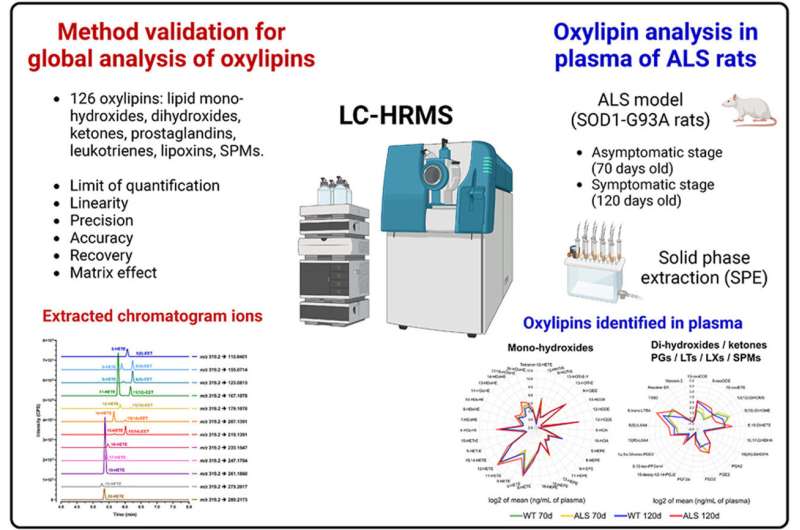This article has been reviewed according to Science X's editorial process and policies. Editors have highlighted the following attributes while ensuring the content's credibility:
fact-checked
trusted source
proofread
Novel method facilitates study of oxidized lipids involved in neurodegenerative diseases

Lipids are a diversified class of biomolecules with a wide array of functions, from energy storage to regulation of fundamental cellular processes. Oxidized lipids have received considerable attention because of their association with oxidative stress, inflammation, and cell signaling. Oxylipins, for example, are bioactive lipids generated by the oxidation of polyunsaturated fatty acids (PUFAs) and have been associated with several neurodegenerative diseases.
Amyotrophic lateral sclerosis (ALS) is an incurable neurodegenerative disease that leads to muscular atrophy, paralysis and death. Scientists at the Center for Research on Redox Processes in Biomedicine (Redoxoma) in Brazil have created and validated a high-throughput method to find out how oxylipins are involved in the development of ALS.
Redoxoma is a Research, Innovation and Dissemination Center hosted by the University of São Paulo's Chemistry Institute (IQ-USP). The study was led by Sayuri Miyamoto, a professor at IQ-USP and the last author of the article on the study published in the journal Free Radical Biology and Medicine.
Validation of the innovative method, which was based on liquid chromatography coupled to high-resolution mass spectrometry, involved simultaneous analysis of126 oxylipins found in blood plasma. Analysis of blood plasma from a rat with ALS using the validated method showed 17 oxylipin alterations reflecting oxidative stress, inflammation, and lipid hypermetabolism. According to the article, oxylipins could become biomarkers for monitoring progression of the disease.
"The method was key in this study. Most methods use low-resolution mass spectrometry to quantify oxylipins and other molecules. It's highly sensitive but lacks accuracy for molecular characterization. High-resolution mass spectrometry characterizes oxylipins with much greater accuracy while maintaining high sensitivity. We combined the two most relevant aspects to characterize a very large number of oxylipins very accurately," said Adriano de Britto Chaves-Filho, the first author of the article.
ALS is a rare neurodegenerative disease characterized by progressive malfunctioning and destruction of motor neurons in the brain and spinal cord, leading to muscle atrophy, paralysis, and death. Lipid metabolism alterations, chronic inflammation, and oxidative stress are strongly linked to progression of the disease.
Oxidative stress
"We constructed a targeted method to quantify 126 oxylipins. Obviously, you don't find them all in a biological sample. We found 56, of which 17 were significantly altered," Chaves-Filho said.
The analysis showed that levels of arachidonic acid-derived oxylipins linked to inflammation and oxidative stress, such as prostaglandins and mono-hydroxides, were higher in plasma from rats with ALS, whereas levels of linoleic acid-derived oxylipins involved in fatty acid uptake and beta-oxidation (DiHOMEs) were lower.
"These DiHOMEs are associated with the hypermetabolism characterized by fatty acid mobilization from adipose tissue for beta-oxidation due to rising demand for energy, which leads to weight loss. In ALS patients, the smaller the amount of adipose tissue, the worse the prognosis. Hypermetabolism is conspicuous in ALS patients, who suffer severe weight loss in the final stages of the disease," Miyamoto said. The group will now investigate the source of these DiHOMEs and their role in ALS.
Another interesting result was an increase in levels of arachidonic acid- and linoleic acid-derived ketones in both 120-day-old ALS rats and controls, suggesting that age also modulates the plasma oxylipin metabolism.
Oxylipins have various biological functions in accordance with their chemical properties. They act as signaling molecules, propagating signals through cells and modifying biomolecules such as protein and DNA. They can be both pro-inflammatory and pro-resolving (promoting the resolution of inflammation). One of the most well-established functions of some oxylipins, such as prostaglandins, is inflammatory process mediation.
According to Chaves-Filho, the findings also open the door to investigation of the mechanisms associated with oxylipin alterations in ALS. Comprehensive analysis of oxylipins remains a challenge. "They're very diverse and have complex isomerism. Many share the same molecular formula, with the same amounts of carbon, oxygen, and hydrogen, but with a different arrangement of these atoms," he said. In addition, they are chemically unstable and found only in small amounts in biological samples.
This is why the analytical method developed by the researchers is important. It can be used to investigate oxylipins in other diseases as well as ALS. "It would be worth comparing ALS with other neurodegenerative diseases, such as Alzheimer's, for example, to see if they have different oxylipin profiles. A comprehensive analysis is needed to establish a panel of altered oxylipins. Each disease may well have a different profile," Miyamoto said.
More information: Adriano B. Chaves-Filho et al, Plasma oxylipin profiling by high resolution mass spectrometry reveal signatures of inflammation and hypermetabolism in amyotrophic lateral sclerosis, Free Radical Biology and Medicine (2023). DOI: 10.1016/j.freeradbiomed.2023.08.019


















